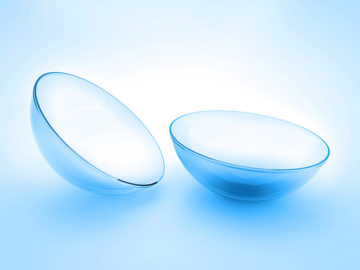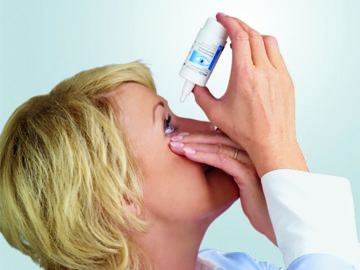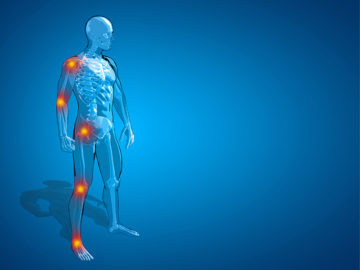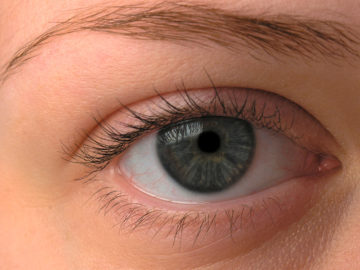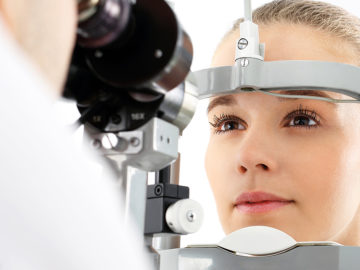Dry eyes due to diseases

The blood sugar levels of a diabetic patient should always be optimally, controlled otherwise there is a risk of permanent damage to the eyes.
Your eyes are red and burn, and every blink causes pain. Dry eyes can seriously impair well-being and vision. The causes of dry eyes can be harmless – for example, working too long in front of a computer monitor.
They can also be concomitant symptoms of a serious disease. Quite often, dry eyes are even the first symptom of an inflammatory rheumatic disease. That is why it is important to visit a doctor if you have persistent dry eyes. You can learn here which illnesses accompany dry eyes.
Rheumatism in the eye: Sjögren’s syndrome
Rheumatism is a complicated clinical picture. Over 100 conditions are encompassed under the term “rheumatism”. Common to all is a chronic inflammation – it can affect joints, muscles, bones, ligaments and tendons. But rheumatic inflammation can also be present in the organs, for example, in the kidney, the intestines or the eye.
Rheumatoid arthritis affects the joints. It is the most common form of rheumatism and also the most common chronic joint inflammation. The disease is incurable, but its progress can be stopped or slowed down with medication. An autoimmune disorder is probably behind rheumatoid arthritis: the body wrongly sends immune cells into the joints, where they stimulate inflammatory processes which, little by little, destroy the joints. Rheumatoid arthritis is often accompanied by dry eyes.
All of the structures in the eye can be affected by the inflammatory processes. Diseases in the eye typically caused by rheumatism are:
- Sjögren’s syndrome
- Dry eyes with inflamed conjunctiva (conjunctivitis)
- Inflammation of the sclera (scleritis)
- Inflammation of the cornea (keratitis)
- Inflammation of the uvea (uveitis)
Dry eyes, sensitivity to glare or blurred vision are just some of the symptoms which can be caused by a rheumatic disease in the eye.
Dry eyes can be both a concomitant symptom of rheumatic diseases (secondary Sjögren’s syndrome) as well as being a rheumatic disease in itself, the so-called primary Sjögren’s syndrome. Primary Sjögren’s syndrome occurs independently, that is without a demonstrable connection to another disease. The cause of Sjögren’s syndrome is an autoimmune disorder in which the endogenous defence system attacks the lacrimal and salivary glands.
Because the salivary glands are usually affected, there is also a dry mouth with inflammation of the gums and the oral mucous membrane. Often, other glands are affected and in addition mucous membranes dry out, for example, in the nose or in the throat or bronchi.
You can find more detailed information on rheumatic diseases, Sjögren’s syndrome and dry eyes in the chapter on rheumatism.
Scleroderma: an autoimmune disorder of the connective tissue
Scleroderma is an autoimmune disease. In this case, the immune system attacks the connective tissue which hardens slowly as a result. It can affect both the skin and the internal organs, such as the lungs or the heart.
Symptoms of scleroderma are circulation problems in the hands and feet as well as a hardening of the skin, especially at the extremities and in the face. The eyelids can also become stiff, such that the eye can no longer close completely. As a result, it dries out slightly. Furthermore, scleroderma patients often develop Sjögren’s syndrome because the salivary and lacrimal glands can also be affected.
Parkinson’s disease: the dying off of nerve cells leads to muscle tremor
Parkinson’s disease affects the central nervous system. Certain nerve cells die by and by causing a lack of the messenger substance dopamine. The consequence is symptoms such as uncontrolled muscle tremor, muscular rigidity and restricted movement. Most people become diseased between the ages of 50 and 80.
In the early stages of the illness, Parkinson’s patients often have eye complaints alongside the known symptoms. They complain about poor eyesight and problems reading; three-quarters of all eye problems are dry eyes. This can be traced to reduced blinking and poor quality lacrimal fluid. Tear secretion is also often decreased.
Diabetes mellitus: diabetes damages blood vessels and nerves
Chronic diabetes has serious effects on the whole body. With diabetes, the regulation of the blood sugar level is disrupted because either too little insulin is produced or the somatic cells no longer react to insulin (insulin resistant). The hormone insulin is responsible for lowering blood sugar. The increased level in blood sugar has an effect on blood vessels and nerve fibres, among other things. In particular, the fine vessels and nerve fibres in the eye are quickly damaged. The eyes become inflamed more quickly because irritation on the surface of the eye is transmitted too late by the damaged nerves to the lacrimal glands and tear productsion is inadequate. Dry eyes are the result.
Thyroid diseases
The thyroid gland can overfunction or underfunction. In a healthy condition, the thyroid is a central control point of the metabolic processes in the body. In the case of an underactive thyroid gland (hypothyroidism), the metabolism is slowed down. Symptoms appear such as tiredness, circulation problems or constipation. The eyes can dry out due to reduced secretion of tears. There is often swelling of the eyelids, which occasionally leads to the eye not completely closing or the tear film not being spread evenly across the surface of the eye. This further nurtures the drying out of the surface of the eye.
In contrast, with an overactive thyroid gland (hyperthyroidism), the metabolism operates at full blast. This produces symptoms such as nervousness, insomnia or high blood pressure. Functional disorders of other glands, for example of the skin or the eyes, also occur. The best known disease linked to an overactive thyroid is Graves’ disease. A main symptom of this autoimmune disorder is protruding eyes, which can lead to an inability to close the eyelids completely and therefore to incomplete lubrication of the surface of the eye. The eyes burn and there is a sensation of having a foreign body in the eye. Because the tear film in the eye evaporates too quickly, the eyes produce more lacrimal fluid to compensate. Paradoxically, the eye waters and yet feels dry.
Virus infections and bacterial infections
Various viruses can be responsible for dry eyes. The herpes virus can damage a particular cranial nerve which then interrupts the transfer of information between the brain and the lacrimal gland. Tear productsion can no longer be stimulated by the brain.
Some viruses infect the lacrimal glands. These then become inflamed and greatly reduce tear productsion. The following viruses can infect the lacrimal gland:
- HIV (trigger for AIDS)
- Mumps virus
- Epstein-Barr virus (trigger for Pfeiffer’s disease)
- Influenza (trigger for real flu)
- Measles virus
Bacteria can also infect the lacrimal glands. These include, for example, the pathogens for scarlet fever, tuberculosis or syphilis.
Skin diseases
If neurodermatitis appears on the face, eczema also often forms around the eyes. This can lead to swelling of the eyelids. The eyes can no longer be closed properly and the uvea dries out slightly. But dry eyes are found time and again in neurodermatitis patients without swollen eyelids. This is particularly the case for people who are affected by the skin disease rosacea.
Treating dry eyes
Dry eyes are not a trivial matter. It is imperative that you take your symptoms to the doctor in order to determine the cause and to receive appropriate treatment.
In the diseases described above, dry eyes are normally in a chronic stage. That is why it is important to lubricate your eyes permanently and regularly with eye drops. Attention should be paid when making a purchase that the eye drops do not contain preserving agents. These can further damage the fragile cornea.





